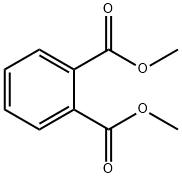131-11-3

Product Name:
Dimethyl phthalate
Formula:
C10H10O4
Synonyms:
Dimethyl phthalate;DMP;Phthalic acid dimethyl ester
Inquiry
CHEMICAL AND PHYSICAL PROPERTIES
| Physical Description | Dimethyl phthalate appears as a water-white liquid without significant odor. Denser than water and insoluble in water. Hence sinks in water. Flash point 300 °F. Eye contact may produce severe irritation and direct skin contact may produce mild irritation. Used in the manufacture of a variety of products including plastics, insect repellents, safety glass, and lacquer coatings. |
|---|---|
| Color/Form | Pale yellow |
| Odor | Slight aromatic odor |
| Boiling Point | 542.7 °F at 760 mmHg (NTP, 1992) |
| Melting Point | 32 °F (NTP, 1992) |
| Flash Point | 295 °F (NTP, 1992) |
| Solubility | less than 1 mg/mL at 68 °F (NTP, 1992) |
| Density | 1.1905 at 68 °F (USCG, 1999) - Denser than water; will sink |
| Vapor Density | 6.69 (NTP, 1992) - Heavier than air; will sink (Relative to Air) |
| Vapor Pressure | 1 mmHg at 212.5 °F ; 5 mmHg at 269.2 °F; 10 mmHg at 297.7 °F (NTP, 1992) |
| LogP | log Kow = 1.60 |
| Stability/Shelf Life | Stable under recommended storage conditions. |
| Autoignition Temperature | 915 °F (USCG, 1999) |
| Decomposition | Hazardous decomposition products: toxic gases and vapors (such as carbon monoxide) may be released in a fire involving dimethylphthalate. |
| Viscosity | 17.2 cP at 25 °C |
| Heat of Combustion | -119.7 kg-cal/mole |
| Heat of Vaporization | 93.1 g-cal/g |
| Ionization Potential | 9.64 eV |
| Ionization Efficiency | Positive |
| Refractive Index | Index of refraction: 1.5168 at 20 °C/D |
| Relative Evaporation Rate | Almost zero (methyl acetate = 1) |
| Kovats Retention Index | 1400 1457 1406 1400 1425 1429.29 1429.44 1431.25 1431.47 1433.14 1440.94 1441.55 1425 1409 1418 1427 1437 1434 1453 1416 1420 1435 1457 1413 1417 1417 1417 1417 1417 1418 1426 1400 1405 1424 1432.5 1453 1406 1406 1414 1414 1481 1402.6 1432 1454.4 257.4 |
| Other Experimental Properties | VOLATILITY: 4.0 MG/SQ CM/HR AT 100 °C |
| Chemical Classes | Plastics & Rubber -> Phthalate Esters |
SAFETY INFORMATION
| Signal word | Danger |
|---|---|
| Pictogram(s) |
 Flame Flammables GHS02  Skull and Crossbones Acute Toxicity GHS06  Health Hazard GHS08 |
| GHS Hazard Statements |
H225:Flammable liquids H370:Specific target organ toxicity, single exposure |
| Precautionary Statement Codes |
P210:Keep away from heat/sparks/open flames/hot surfaces. — No smoking. P260:Do not breathe dust/fume/gas/mist/vapours/spray. P280:Wear protective gloves/protective clothing/eye protection/face protection. P311:Call a POISON CENTER or doctor/physician. P301+P310:IF SWALLOWED: Immediately call a POISON CENTER or doctor/physician. |
COMPUTED DESCRIPTORS
| Molecular Weight | 194.18 g/mol |
|---|---|
| XLogP3 | 1.6 |
| Hydrogen Bond Donor Count | 0 |
| Hydrogen Bond Acceptor Count | 4 |
| Rotatable Bond Count | 4 |
| Exact Mass | 194.05790880 g/mol |
| Monoisotopic Mass | 194.05790880 g/mol |
| Topological Polar Surface Area | 52.6 Ų |
| Heavy Atom Count | 14 |
| Formal Charge | 0 |
| Complexity | 200 |
| Isotope Atom Count | 0 |
| Defined Atom Stereocenter Count | 0 |
| Undefined Atom Stereocenter Count | 0 |
| Defined Bond Stereocenter Count | 0 |
| Undefined Bond Stereocenter Count | 0 |
| Covalently-Bonded Unit Count | 1 |
| Compound Is Canonicalized | Yes |
PRODUCT INTRODUCTION
description
Dimethyl phthalate appears as a water-white liquid without significant odor. Denser than water and insoluble in water. Hence sinks in water. Flash point 300 °F. Eye contact may produce severe irritation and direct skin contact may produce mild irritation. Used in the manufacture of a variety of products including plastics, insect repellents, safety glass, and lacquer coatings.